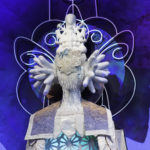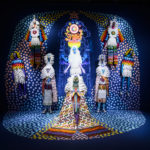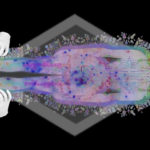Saya Woolfalk
The Empathics

Saya Woolfalk, Empathic Cloud Divination, installation view at Tube Factory, 2020. Image courtesy the artist.
Speculative fiction has the potential to help us imagine other worlds with other social structures. If we can imagine other cultural practices, other social relations which are possible, then we gain access to other possible futures and to other possible ways of being. That’s the real intention of the speculative. The speculative is not just looking forward. It’s looking back, it’s looking sideways, it’s looking out to future possibilities. It’s not just saying “what if.”
Wandering in a forest somewhere upstate, yellowing leaves dropping from silver birches overhead. It’s been a while since the seasons reversed: sunburnt sweating in the winter cold, shivering at the beach on the summer solstice – a weirded climate normalised, weather management systems downplaying the slow apocalypse into a non-issue. Losing yourself in thought, your attention suddenly snaps back to a nearby shimmer. Looking out under a sycamore, there you see them: a cluster of clavicles, rib cages, femurs, vertebrae, flourishing with mushroom colonies enmeshed, bright white overlaid with holographic green. It’s impossible to tell where bone ends and fungus begins; in this network of more-than-human life, a chimera is born.

Saya Woolfalk, Expedition to the ChimaCloud, 2019. Installation View Nelson-Atkins Museum of Art, Kansas City. Image courtesy the artist.
In her multi-headed practice, which sees projects spanning over a decade, Saya Woolfalk uses tactics of speculative fiction and multispecies hybridity to complicate boundaries between humans and plants, fantasy and reality, utopia and dystopia. Collaboration is a core component of her work, and this porosity folds in a host of research methods from anthropology and biology, to choreography and filmmaking. Built across painting, sculpture, video, installation, mural, and performance, Woolfalk’s worlds are generative systems for prototyping transformation – they embrace social, political, and ecological entanglements – and as a result, they feel simultaneously futuristic and otherworldly, but also incredibly close to the world we already inhabit.
Since 2009, Woolfalk has worked on The Empathics, a multilayered project of worldbuilding that spans a fictional social system, spirituality, corporation and research institute run by the Empathics, who are a fictional race of women who can alter their generic makeup and merge with plants. They can grow extra spines, legs, heads; their skins are made from lace, butterflies, pearls, and animal symbols. In this ecofeminist folktale, the superpower of hybridity emerged by uncovering chimeric bones, remnants of an ancient plant-human hybrid species lost to time, that triggered a metamorphosis into the Empathics’ current state.
“With each project,” suggests Woolfalk, “I want a person to experience something that simultaneously makes them slightly uncomfortable about the potential of the world that I have created, but also gives them an excitement about a harmonious, multi-cultural society.”

Saya Woolfalk, Chimera. Installation view at MOCA Taipei, Taiwan, 2013. Image courtesy the artist.
So, our world is super fucked. I think that to be aware of what’s coming next, to be aware of our participation in these systems, it’s super important to think about what’s next. It’s also super important to think about what happens when we start to collapse this system. I think that what we’re failing to do is imagine something different. Our imaginations are limited to go one direction, and I think that what I do, whether it’s national or international, I’m hoping to act as an ad-hoc tour guide to help imagine the unimaginable. I think speculative fiction asks us to imagine what it would be like to live in a different world, to think about how we might build a world that is more empathetic and forgiving, a world that is not bound by systems of race and class and gender.
Often when I’m building worlds, I think of inviting people into my imagination so that they can take things. Then they can bring them back into their real lives and encourage their communities to do the same. I’m not sure what futures I hope to see, but I do think that when we break the glass in the future, it should be with utopia in mind.
Working from a wide pool of sources, The Empathics fuses artefacts and rituals spanning space and time: from spiritual practices in Brazil, to Native American baskets, Tantric paintings, masks made in the Sande Society in Sierra Leone, and Japanese textiles. In Woolfalk’s haptic world, these multicultural influences are woven together with western temples of consumer culture, perhaps best epitomised by shopping malls and Times Square billboards. ChimaTEK, a later phase in The Empathics project, sees the fictional society’s nonprofit Institute of Empathy morph into marketable commodities.
Woolfalk worlds in a space that considers the various social and political thresholds of utopia – including its capacity to be marketed and positioned as a commodity. The Empathics fold this anticipation of capitalism realism into their practice, of which they are inextricably, and self-consciously, involved. Despite materialising in a forest, the Empathics’ Institute of Empathy sells relics of themselves to fund their research practice; they vend “Life Product Systems” in galleries in Brooklyn, offer soul uploads to the ChimaCloud, premiere their latest products on Times Square billboards, and download VR crystals in downtown Manhattan malls.

Saya Woolfalk, ChimaTEK: ChimaCloud Control Center, 2016. Live performance documentation. Image courtesy the artist.
But the speculative company is also attuned to the demands of the art market, and deftly navigates those desires to inject a density of meaning and political possibility into a layered body of work that also presents itself as immediately visually engaging, broadly accessible, and yes, Instagrammable. ChimaTEK’s Virtual Chimeric Space, for instance, is a technicolor playground previously installed at the Seattle Art Museum.
Woolfalk’s multimedia immersive environments combine storytelling through objects, female initiation rituals, anthropology, mythology, digital avatars and virtual beings, and local dancers, to merge material and digital worlds through movement. In its strategic use of curiosity and play, The Empathics works – like any good folk tale – on multiple thresholds, where an imaginative story becomes a metaphorical scaffold for exploring salient topics of gender, race, politics, and environmentalism.
I think the Empathics are here to provide us with a sort of imagineering for our future. They are dual headed dual-bodied creatures that are able to see both forward backwards in time. Using the ChimaCloud, they are able to download possible futures then choose or to choose not to make them real. That is something that I believe humans could to do be doing better.

Saya Woolfalk, video still from The Empathics, 2012. Courtesy the artist.
I think the Empathics are here to provide us with a sort of imagineering for our future. They are dual headed dual-bodied creatures that are able to see both forward backwards in time. Using the ChimaCloud, they are able to download possible futures then choose or to choose not to make them real. That is something that I believe humans could to do be doing better.
In science fiction there can definitely be a sense of escapism, but I take science fiction seriously. Some people don’t think it’s possible for science fiction to be art, but I think I’ve tried to intervene in that paradigm a bit in a revisionist history. I think it can be a powerful tool in helping us to not only imagine a future that we don’t want, but also a future that we want. The question that people have about sci-fi is, “Is it real?” I think that when we examine the themes in the stories, we can sometimes learn how to build a different kind of reality. In “Chimaclon,” for example, there’s a question about whether or not the Empathics’ desire for a world in which racial boundaries are not so much racial boundaries is at all possible. Again, it’s set in the future, but is this even feasible? It’s not by any means an achievable goal, but I think it’s not impossible.

Saya Woolfalk, ChimaTEK Beta Launch. Installation view from Smack Mellon, 2014. Photo Credit: Etienne Frossard, image courtesy the artist.
Born in Japan and raised in New York State, Woolfalk’s intercontinental upbringing and multicultural heritage informs her interests in hybridisation and building more equitable possible futures, but these ideas are infused across layers in her work. Inspired by speculative fiction authors like Ursula K. Le Guin and Octavia Butler – whose stories, which often fall under the category of ‘science-fiction’, are equally as concerned with topics of race, class, gender, and interspecies collaboration – the Empathics. ““Because I’m mixed race, I have this idea that to leave the conversation ambiguous is interesting,” suggests Woolfalk.
I mean, I’m half African-American, half European-American, half Japanese. I’m one-third African-, African-Euro-American, European-American, and I’m one-third Japanese. I’m so hyphenated – I’m so full of hyphens – it’s like the early 1900s.
I want to find a way to talk about a version of a future where a lot of things have changed, but also how we remain the same, but also how we remain connected to each other, to our communities, o the environment. In the ’60s, the language I would have used was “hydraulic fracturing.” In the 21st century, I’m using the language of multispecies communication. In my practice, I call this project “In our many languages, with many tongues, we speak…”

Saya Woolfalk, video still from The Empathics, 2012. Courtesy the artist.
As we envision the future, we think about how we can be empathetic and how we can imagine other people who we share this planet with. My latest project is about the possibility of experiencing another world that has already happened. So what I’m doing is setting up machines in museums that when you put your hands on the machine it takes you into an experience where you can have a sense of what it might have been like in another time.
The ethical dimension of an ever-expanding technological field is also a principal concern of the Empathics, who are themselves a transhumanist race that has benefitted socially and existentially from moving beyond binaries and biases that still ensare the modern world. But as advanced as the Empathics are, much of their world-view remains entangled with issues of the human.
As part of its research praxis, the Empathic’s Institute works towards a distributable metamorphic system so that any human can opt into becoming an Empathic. In ChimaCloud, the Empathics wrestle with the morality of introducing a novel piece of technology that would increase global empathy output, but with wildly unpredictable social side-effects. They weigh the pros and cons of bio-engineering people, plants, nature, and animals. Just like in Le Guin’s The Dispossessed, in which an interstellar conflict between two societies with radically different social views acts as a stand-in for the comparative critique of capitalist and socialist systems on Earth, The Empathics deal with a set of seemingly “posthuman” concerns that are ultimately not too different from our own.

Saya Woolfalk, ChimaCloud: Gate, 2017. Single-Channel HD Video Projection. Image courtesy the artist.
This world that we live in is full of Euro-centric paradigms that prevent us from doing that. I am trying to get people to think more widely about the possibilities of things, more widely about the sciences they engage in, more widely about the way that they think about things. For example, the more that we understand how the environment works, the more that we understand how people work, the more that we understand how minds work, the more that we are more inclined to have empathy for things that are outside of our purview right now.
In the creation of reality, I’m not sure there’s a line between utopia and dystopia…. Utopia is not possible in a black and white sense. It’s gray, I’d say. I think that it might be interesting that what we’re really trying to do is to ascend to another kind of life form.
In many ways, the Empathics’ capacity to move beyond seemingly all-too-human issues of race, gender, politics, and society is also a move towards an interspecies approach to the future. It is an approach that acknowledges the complexities of hybridity and the mutual accountability that comes with a non-anthropocentric relationship to the Earth — in Haraway’s terms, of staying with the trouble.

Saya Woolfalk, ChimaCloud and the Pose System. Image courtesy the artist.
If we commit to the notion of the multispecies, we have to have human imagination aligned with the imagination of other species to imagine other realities. This imagination leads us to the creation of new technologies, new arts forms, new being with each other. It’s about being open to imagining new possibilities. How are we going to imagine this shared reality, what are the ways that we’re going to build this shared reality together?
The elaborate multimedia installations that comprise much of The Empathics project is a kind of stage for testing these alternative realities, together. Woolfalk’s use of performance in her storytelling – choreographed dance in particular – conjures a kind of slippage point where the utopian and chimerical nature of the Empathics are momentarily materialised in a physical dimension, a moving body. This creates a space where non-verbal forms of knowledge built by the Empathics can be transferred to a human audience without relying on language.
We begin to comprehend their existence as one that’s constantly in flux: they metamorphose, change colors, and eventually become part of the landscape when they die, in a way that recalls the mantra of Butler’s Parables series – “All that you touch / You Change / All that you Change Changes you / The only lasting truth is Change / God is Change.” By creating a more permeable space to speculate on the many possible futures of the future, The Empathics foregrounds the potentials and pitfalls of technological sublimation while underscoring the role of multispecies collaboration. It posits a future as nature, as plant and animal and yet still human, in a ritual of collaborative dreaming and becoming.

Saya Woolfalk, Visual Reality Portal, installation view at The Peninsula Paris, 2019. Image courtesy the artist.
We don’t get a perfect language, a perfect world, a perfect justice, a perfect equality, a perfect environment. We get a chance to get a little bit closer. The next thing that has to happen is that we have to have a vision of how we get there, what that looks like. What would the other world look like?
In the story “The Empathics,” the Empathics have a vision of a holographic city in outer space, a quasi-utopian space, a life product system where you have a floating city where everyone is a hybrid, a quintessential being where everyone can have a second head a wing a third a fourth a fifth a sixth a seventh a half a body a third a four a fifth a sixth a body a whole other body a city in space. That’s what they’re envisioning. That’s what it will take to get us there.
Saya Woolfalk, Empathic Cloud Divination installation walkthrough, 2020.











